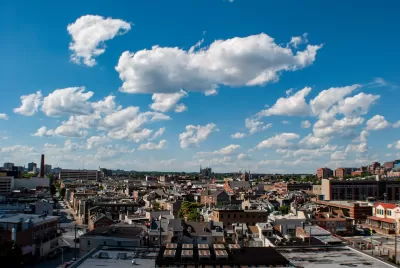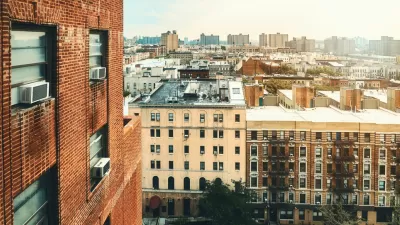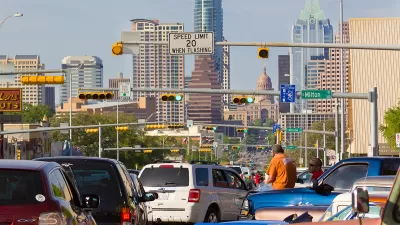Rising property values come with positive community development, but this shift can make neighborhoods inaccessible to low-income renters and fixed-income homeowners.

It’s time for some straight talk about rising property values. Yes, they help amass equity for homeowners, provide opportunities for developers, and generate revenue for localities. But they also raise rents, pushing out low-income renters; keep the unhoused, unhoused; and push fixed-income homeowners into fiscal precariousness. If community development is about the entire human community, and not just real estate, we must grapple with this tension. Higher property values and equitable development are not an easy marriage.
Parks, new housing, calm traffic, quality schools, the presence of grocers and other businesses, increased street lighting, a sense of community safety, blight reduction, and neighborhood cohesion all push property values higher. So does almost every aspect of positive community development. Remedying the racial imbalance in wealth creation through homeownership relies, to a great extent, on this property value appreciation. But if pushing values up for existing homeowners requires pushing out low-income homeowners and renters of limited means, and creates fewer affordable housing options for unhoused people, we have a quandary.
Baltimore distinguished itself in the post-World War II period as a city of homeowners. Almost two-thirds of its residents owned in the early 1950s, before government-subsidized and racially covenanted suburbs facilitated white flight, and the dynamics of increased global competition encouraged manufacturers to exit. Only 48 percent of the city’s residents own today, in a city that is about 62 percent African American.
Since that postwar peak, the value of homes in many neighborhoods has dropped.
Neighborhoods on both the west and east sides of the city that were redlined by the U.S. Home Owners Loan Corporation in a 1937 map are now, in the city’s 2017 Housing Market Typology map, marked as areas with sales values about 80 to 90 percent below average in Baltimore.
But on the east side, real estate developers transformed warehouses, flophouses, and wharves into luxury housing, thereby pushing up the property values of adjacent neighborhoods that had previously been classified as “stressed.”
It is in those ‘stressed’ neighborhoods that SHARE Baltimore’s network of community land trusts operates, and where we see firsthand the mixed blessing of high property values.
Low property values in the stressed neighborhoods—on both the east and west sides of Baltimore—discouraged property sales by homeowners for decades, facilitated homeowner-to-rental conversion, and contributed to a vacant housing stock in Baltimore that ranges from 16,000 to 47,000, depending on who’s counting. But, as property values on the east side now rise, vacant houses in stressed neighborhoods adjacent to prime neighborhoods are now becoming attractive to market-rate minded developers. As our CLTs seek to acquire these same vacant houses to rehab into permanently affordable homes, the competition with market-rate developers has pushed up our acquisition costs.
While most would assume that homeowners in these stressed neighborhoods on the east side would welcome the competition between developers and CLTs because it ultimately pushes up their own property values and increases home equity, it is not so simple.
Please see the source article linked below to continue reading.
FULL STORY: The Dirty Little Secret—Rising Property Values Are Incompatible with Affordability

Planetizen Federal Action Tracker
A weekly monitor of how Trump’s orders and actions are impacting planners and planning in America.

Congressman Proposes Bill to Rename DC Metro “Trump Train”
The Make Autorail Great Again Act would withhold federal funding to the system until the Washington Metropolitan Area Transit Authority (WMATA), rebrands as the Washington Metropolitan Authority for Greater Access (WMAGA).

DARTSpace Platform Streamlines Dallas TOD Application Process
The Dallas transit agency hopes a shorter permitting timeline will boost transit-oriented development around rail stations.

San Francisco's School District Spent $105M To Build Affordable Housing for Teachers — And That's Just the Beginning
SFUSD joins a growing list of school districts using their land holdings to address housing affordability challenges faced by their own employees.

Car-Centric LA Suburb Looks to a Train-Oriented Future
City leaders in Rancho Cucamonga, the future western terminus of the Brightline West rail line to Las Vegas, want to reimagine the city as a transit-oriented, pedestrian-friendly community.

New Alaska Bitcoin Mine Would Burn as Much Energy as the State’s Largest Coal Plant
Fueled by “stranded” natural gas, the startup hopes to become the largest in the US, and to make Alaska an industry center.
Urban Design for Planners 1: Software Tools
This six-course series explores essential urban design concepts using open source software and equips planners with the tools they need to participate fully in the urban design process.
Planning for Universal Design
Learn the tools for implementing Universal Design in planning regulations.
Municipality of Princeton
Roanoke Valley-Alleghany Regional Commission
City of Mt Shasta
City of Camden Redevelopment Agency
City of Astoria
Transportation Research & Education Center (TREC) at Portland State University
US High Speed Rail Association
City of Camden Redevelopment Agency
Municipality of Princeton (NJ)





























